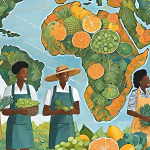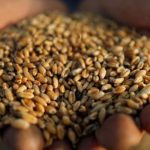[tta_listen_btn listen_text=”Audio” pause_text=”Pause” resume_text=”Resume” replay_text=”Replay”]
AFRICA is enjoying increased fruit exports to Europe, the United Kingdom and Asia, helping to fill a growing supply gap occasioned by low harvests in those markets, helped by increased production methods and yields across the continent.
According to the EU Citrus Semi-Annual Report, the production of citrus fruits in Europe is expected to decrease by 10% in the 2022/23 season, with Spain experiencing the largest decline, and African producers are stepping in to fill the gap.
The combined impact of insufficient spring rains, a warmer summer and drought experienced up to May 2023, the report said, have compromised the EU’s citrus production, particularly oranges and lemons.
Conversely, African countries are recording higher fruit harvests despite heavy rainfall in some countries like South Africa and a lack of sufficient water in Morocco, signalling an expansion of the area under commercial fruit production on the continent.
South African Citrus Growers Association (CGA) data shows that by mid-June, 4 million (15kg cartons) of Navel orange – South Africa’s popular seedless orange variety – had been shipped to export markets, compared to 2.5 million cartons in a similar period in 2022.
“Recent supplies to the EU have been high, which could impact the market; however, the data does show a slowdown in supply going forward – the heightened supply of the past few weeks could fill the gap over the next few weeks,” said CGA CEO Justin Chadwick, implying that prices would remain stable despite the major increase in shipments.
As demand for African fruit grows, African export sales bolstered have also been bolstered by competitive pricing advantages thanks to significant drops in a number of African currencies against the dollar, euro, pound and Asian currencies.
In its latest analysis, global commodity price data and market intelligence firm Mintec Global also shows Navel Oranges exporters reaping it big in Europe and the UK on lower harvests of Spanish Oranges.
According to the market intelligence firm, a 15% drop in Spanish orange harvests has seen their prices rise by 60% to US$ 1.32/kg. Navel oranges go for US$ 0.20/kg in that market.
“Despite heavy rainfall in the Western Cape, the country is experiencing a strong orange harvest and robust demand from EU and UK markets. South African oranges are now playing a crucial role in filling a supply gap in Europe during a period when the Spanish citrus harvest has ended, and there is limited other supply available,” the Mintec report said.
South Africa accounted for 7% of all orange supplies into the European market in 2022, with Egypt, Morocco, Zimbabwe, Argentina and Uruguay sharing a further 6%.
Supplies from Spain, Italy and Greece accounted for 87% – the largest share in 2022.
CGA’s export forecast also points to a boom in lemon production – from South Africa, Zimbabwe and Eswatini – in 2023, with a projected volume of 37.3 million (15kg) cartons in 2023. That would see 2.6 million more cartons supplied to export markets compared with 2022.
Zimbabwean exporters are also gearing up to enter Asian markets after the General Administration of Customs of China on June 1, 2023, authorised six Zimbabwean orchards and 11 packing houses to start exporting citrus.
The landlocked country will ship citrus through third countries and must adhere to China’s mandatory cold treatment requirement to avoid pest transmission during the shipment of the fruits.
In June 2022, South Africa suffered a temporary freeze on citrus exports after the EU implemented new phytosanitary rules requiring enhanced cold treatment for orange imports from Africa. The rule changes had been occasioned by concerns over the False Coddling Moth (FCM), a pest that affects citrus fruit.
Egypt is also playing a major role in supporting landlocked countries supplying citrus to EU markets. Between January and May, the North African economy supplied 347,576 tons, accounting for 94.9% of imported oranges to the EU from third countries, according to an agriculture-focused website, FreshPlaza.
Another horticulture analytics platform, East-Fruit International, shows Moroccan watermelon exports to the EU doubled over the last six years to 300,000 tonnes, defying low water levels and low rainfall in the country.
France (42%) and Spain (33%) were the main export destinations for Moroccan watermelons in 2022.
East-Fruit International also shows Egyptian frozen strawberries having a good run in European and Asian markets.
Egypt accounted for about two-thirds of the EU’s total imports of frozen strawberries from non-EU countries in 2022, surpassing Morocco, which in 2018 was the leading exporter of frozen strawberries to the EU, with volumes of 60,000 tonnes.
East-Fruit International links
Who loves Moroccan watermelons the most?
Egypt doubles frozen strawberry exports to the EU in the past five years













